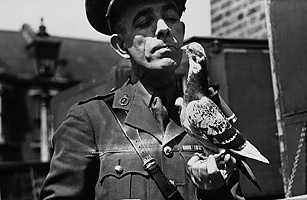
Pigeons aren't considered the smartest of our feathered friends, but the incessantly cooing, bread-crumb-eating birds have their uses. During World War I and WW II, the U.S. military enlisted more than 200,000 pigeons to conduct surveillance and relay messages. From 1917 to 1957, New Jersey's Fort Monmouth served as the breeding and training ground for these avian soldiers. The pigeons flew hundreds of miles, averaging speeds of a mile a minute, with messages strapped to their legs in tiny capsules. Historians believe that more than 90% of the missives were delivered successfully.
One notable pigeon named Cher Ami ("Dear Friend" in French) flew for the U.S. Army Signal Corps in France during WW I. He flew 12 important messages before being struck by enemy fire. Despite being shot in the breast and leg, he managed to deliver the message, which was found dangling from his shattered leg. His brave dedication to the mission led to the rescue of 194 soldiers in Major Charles Whittlesey's "Lost Battalion." Cher Ami, who died in 1919, likely as a result of his battle wounds, was awarded the French Croix de Guerre award for his heroic service and was inducted into the Racing Pigeon Hall of Fame in 1931. His one-legged body is on display at the Smithsonian National Museum of American History's "Price of Freedom: Americans at War" exhibit in Washington, D.C.